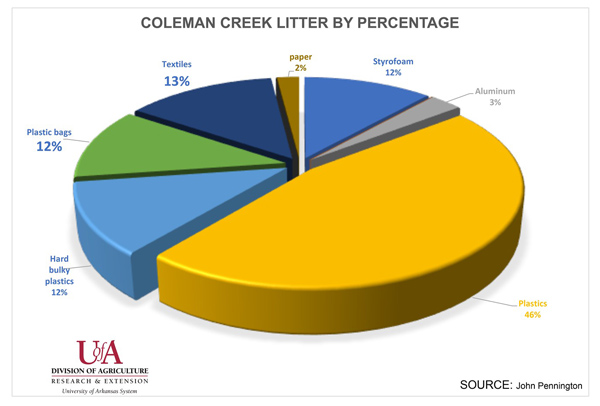Volunteers sought for Buffalo River Watershed litter audit
Nov. 18, 2022
By the U of A System Division of Agriculture
Fast Facts:
- Buffalo River Watershed Enhancement Project working to reduce soil erosion, improve water quality
- Participation expands beyond Natural Resource Conservation Funding
- Litter audit for Buffalo River Watershed seeking participants and volunteers
(421 words)
LITTLE ROCK — The Cooperative Extension Service is seeking volunteers across the state
to assist with a water quality milestone of the Buffalo River Watershed Management
Plan.
Extension — the public outreach arm of the University of Arkansas System Division of Agriculture — is looking to work with stakeholders to conduct a trash index and audit, removing trash from designated areas along the river and to assess the level, types and volume of trash. Public input from residents, landowners and managers in the Buffalo River Watershed is being sought to help guide the effort.
John Pennington, extension water quality educator for the Division of Agriculture, said the process, also known as a “litter audit,” can be “very helpful for anyone seeking to better understand the demographics of the trash in the waterway.”
“Once the details of the litter are recorded and analyzed, a pattern can often be identified that helps guide associated education and outreach activities to assist in the reduction of litter in the environment,” Pennington said.
Litter audits of streams and other waterways can sometimes provide surprising glimpses into the state of stream pollution. A recent litter audit conducted on Coleman Creek in downtown Little Rock revealed that more than 68 percent of the litter in the creek was plastic,
with about half of that plastic being recyclable.
“From this data, it is possible to see that plastic is a very large environmental pollutant of Coleman Creek in fall of 2022,” Pennington said. “It would take more data to develop a trend, but this snapshot of information does help provide insight into the greatest volume of litter that almost any person can help prevent from going to the environment.”
Similar data would be useful in the Buffalo River Watershed, Pennington said. The audit is also directly prescribed as a “study of need” in the watershed.
Participants interested in assisting the Buffalo River Litter Audit should contact their local county extension agent, who can be found here.
The Cooperative Extension Service has partnered with multiple agencies and organizations, including the Nature Conservancy, the U.S. Department of Agriculture’s Natural Resources Conservation Service and others to form the Buffalo River Watershed Enhancement Project, which seeks to help reduce the forces of soil erosion. The partnership makes hundreds of thousands of dollars in grant funding available to landowners participating in the project each year. To learn more, visit https://www.uaex.uada.edu/environment-nature/water/buffalo-river-project.aspx.
For more information on water quality, watersheds, Arkansas Watershed Stewards Program or the Buffalo River Watershed Regional Conservation Program check in with your local county extension office.
To learn about extension programs in Arkansas, contact your local Cooperative Extension Service agent or visit www.uaex.uada.edu. Follow us on Twitter and Instagram at @AR_Extension. To learn more about Division of Agriculture research, visit the Arkansas Agricultural Experiment Station website: https://aaes.uada.edu/. Follow on Twitter at @ArkAgResearch. To learn more about the Division of Agriculture, visit https://uada.edu/. Follow us on Twitter at @AgInArk.
About the Division of Agriculture
The University of Arkansas System Division of Agriculture’s mission is to strengthen agriculture, communities, and families by connecting trusted research to the adoption of best practices. Through the Agricultural Experiment Station and the Cooperative Extension Service, the Division of Agriculture conducts research and extension work within the nation’s historic land grant education system.
The Division of Agriculture is one of 20 entities within the University of Arkansas System. It has offices in all 75 counties in Arkansas and faculty on five system campuses.
Pursuant to 7 CFR § 15.3, the University of Arkansas System Division of Agriculture offers all its Extension and Research programs and services (including employment) without regard to race, color, sex, national origin, religion, age, disability, marital or veteran status, genetic information, sexual preference, pregnancy or any other legally protected status, and is an equal opportunity institution.
# # #
Media Contact:
Ryan McGeeney
rmcgeeney@uada.edu
@Ryan_McG44
501-671-2120
